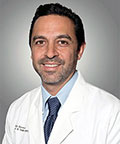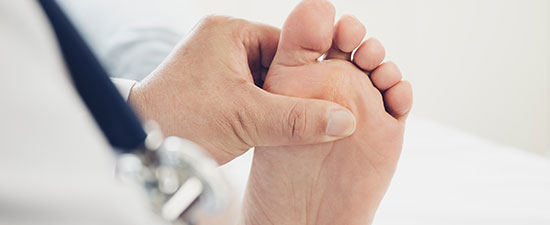- Home
- Foot & Ankle Conditions
- Plantar Plate Injuries
Plantar Plate Injury: causes, symptoms and treatments
What's the plantar plate?
The plantar plate is a strong ligament on the bottom of the foot. It’s a fibrous structure that connects the base of your toe (proximal phalanx) to the forefoot bone (metatarsal head). The plantar plate runs through the joint capsule within the forefoot. Each of your toes, from the big toe to the pinky, has a plantar plate.
Plantar plates keep the toes in place and stop them from over-extending or drifting. As a stabilizer for the metatarsophalangeal joints, plantar plates act as an attachment site for the plantar fascia and your other ligaments and tendons.
A plantar plate tear or injury (sometimes called pre-dislocation syndrome) may be more common than you realize, and you may have even suffered one. Because a common symptom of a plantar plate injury is the second or third toe crossing over its neighbor, these injuries are also called “crossover toe deformities.”
- What causes plantar plate tears?
- What are the symptoms of a plantar plate injury?
- Diagnosing a plantar plate tear
- Conservative treatments for plantar plate injuries
- Plantar plate repair surgical intervention techniques
- Which is better, Arthrex CPR or the HAT-TRICK procedure?
- What is plantar plate surgery recovery time?
- How to prevent plantar plate tears
- UFAI has the most advanced procedures to treat your plantar plate injury
- Frequently Asked Questions about Plantar Plate Tears and Plantar Plate Surgery
- Can a plantar plate tear heal on its own?
- What is the success rate for Plantar Plate repair surgery?
- Can you recommend some good shoes for plantar plate injuries?
-
Foot and Ankle Surgeon and Director of University Foot and Ankle Institute
Dr. Bob Baravaria DPM, FACFAS is a Board-Certified Podiatric Foot and Ankle Specialist. He is an assistant clinical professor at the UCLA School of Medicine and serves as Director of University Foot and Ankle Institute.
Dr. Baravarian has been involved in athletics his entire life and played competitive tennis in high school and college. He has an interest in sports medicine, arthritis therapy, and trauma/reconstructive surgery of the foot and ankle. He is also fluent in five languages (English, French, Spanish, Farsi, and Hebrew),
Learn More from our Plantar Plate Blog Articles
 Dr. Chan is superb. Appointments have always gone smoothly here. Definitely worth the visit.J.P. Y.
Dr. Chan is superb. Appointments have always gone smoothly here. Definitely worth the visit.J.P. Y. Overall, it was a great experience. I've been coming to Dr. Kellman for about a year and he and his staff are very helpful.Vanessa W.
Overall, it was a great experience. I've been coming to Dr. Kellman for about a year and he and his staff are very helpful.Vanessa W. ExcellentDebasish M.
ExcellentDebasish M. My experience with Dr. Barvarian and the staff from the helpful receptionist to the physical therapist, everyone is knowledgeab...Antonio C.
My experience with Dr. Barvarian and the staff from the helpful receptionist to the physical therapist, everyone is knowledgeab...Antonio C. Everyone was friendly and professional.Victor L.
Everyone was friendly and professional.Victor L. Thank you Dr. Fransen from Valencia CA. One of the best Doctors in the world! Great service, amazing treatment!Arcgraphix A.
Thank you Dr. Fransen from Valencia CA. One of the best Doctors in the world! Great service, amazing treatment!Arcgraphix A. Very efficient and an excellent serviceHorwitz J.
Very efficient and an excellent serviceHorwitz J. Chaos in the office checkin. We weren’t forewarned about the iPad data collection. That made me late for a following appointmen...Carl C.
Chaos in the office checkin. We weren’t forewarned about the iPad data collection. That made me late for a following appointmen...Carl C. Dr Nalbandian is an exceptional doctor and person. The staff respectfully & compently delt with an issue I had regarding a prev...Karen M.
Dr Nalbandian is an exceptional doctor and person. The staff respectfully & compently delt with an issue I had regarding a prev...Karen M. Visiting the office is a pleasurable occurance.Thomas J.
Visiting the office is a pleasurable occurance.Thomas J. Dr Kelman and his staff are always wonderfully caring and respectful to my father who has Alzheimer's dementia.Erland E.
Dr Kelman and his staff are always wonderfully caring and respectful to my father who has Alzheimer's dementia.Erland E. Thank you for being there for your patients.Dieter B.
Thank you for being there for your patients.Dieter B.




